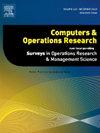A selection hyper-heuristic approach to the single airport slot allocation problem
IF 4.3
2区 工程技术
Q2 COMPUTER SCIENCE, INTERDISCIPLINARY APPLICATIONS
引用次数: 0
Abstract
There is a significant imbalance between air traffic demand and airport capacity at many congested airports. As a result, airlines are required to request time slots for aircraft take-off or landing. The effective allocation of slots forms the basis of the single airport slot allocation problem. A significant amount of existing research on this problem focuses on mathematical modelling and exact solution methods for relatively small-scale problem instances. As the computational effort required for such approaches can be prohibitive as the size of a problem increases, heuristic search methods are often deployed as a more practical alternative. In this paper, we propose a new hyper-heuristic solution approach based on adaptive large neighbourhood search. The proposed approach consists of two stages, a constructive stage, which quickly generates initial feasible solutions, and an improvement stage, which attempts to improve an incumbent solution through an iterative process of destroy and repair. In the improvement stage, five destroy operators are used to modify a solution, including a novel operator which identifies a set of related slot requests to be rescheduled. The destroy operators are selected by an adaptive selection hyper-heuristic according to their past performance. The results using data from a real-world airport show that the proposed approach can provide near-optimal solutions within two hours, whereas a commercial solver can only find feasible solutions of much lower quality within the same time frame.
单机场机位分配问题的选择超启发式方法
在许多拥挤的机场,空中交通需求和机场容量之间存在严重的不平衡。因此,航空公司需要申请飞机起飞或降落的时间段。机位的有效分配是解决单机场机位分配问题的基础。目前对该问题的大量研究主要集中在相对小规模问题实例的数学建模和精确求解方法上。由于随着问题规模的增加,此类方法所需的计算量可能会令人望而却步,因此启发式搜索方法通常被部署为更实用的替代方法。本文提出了一种基于自适应大邻域搜索的超启发式求解方法。建议的方法包括两个阶段,一个是建设性阶段,它迅速产生初步可行的解决方案;一个是改进阶段,它试图通过破坏和修复的迭代过程来改进现有的解决方案。在改进阶段,使用五个销毁算子来修改解决方案,其中包括一个新算子,该算子识别一组需要重新调度的相关插槽请求。销毁操作符采用自适应选择超启发式算法,根据销毁操作符过去的表现选择销毁操作符。使用真实机场数据的结果表明,所提出的方法可以在两小时内提供接近最优的解决方案,而商业求解器只能在相同的时间框架内找到质量低得多的可行解决方案。
本文章由计算机程序翻译,如有差异,请以英文原文为准。
求助全文
约1分钟内获得全文
求助全文
来源期刊

Computers & Operations Research
工程技术-工程:工业
CiteScore
8.60
自引率
8.70%
发文量
292
审稿时长
8.5 months
期刊介绍:
Operations research and computers meet in a large number of scientific fields, many of which are of vital current concern to our troubled society. These include, among others, ecology, transportation, safety, reliability, urban planning, economics, inventory control, investment strategy and logistics (including reverse logistics). Computers & Operations Research provides an international forum for the application of computers and operations research techniques to problems in these and related fields.
 求助内容:
求助内容: 应助结果提醒方式:
应助结果提醒方式:


